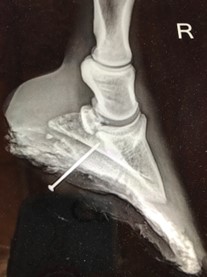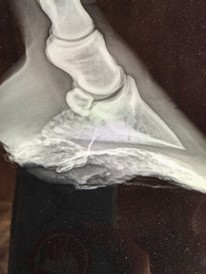No matter how safe their environment may be, horses will always manage to find trouble. Unfortunately, a not-so-uncommon equine emergency is a sharp object that has penetrated through the bottom of the hoof, also known as a street nail. Any penetrating injury to the bottom of your horse’s foot is an emergency, and timely assessment is essential for the best outcome.
The number one rule for the horse owner is NEVER REMOVE THE NAIL before talking with your veterinarian! The exact location of the nail is crucial for determining the best treatment for your horse. ALWAYS call your vet first! Sometimes a photo can help your vet offer the best advice before evaluation.

In general, foreign objects to the back third of the foot present the highest risk because of the position of important structures and the consequences of infection.

Your vet will take radiographs of your horse’s foot prior to removal of the nail to determine its exact location. If the nail has been removed or fallen out, special dye can be injected along its tract that will show up on the radiographs, but it is more informative to leave the nail in place if possible! If the nail falls out prior to evaluation, save it and mark the depth of its tract if possible.

The next step is beginning treatment, depending on the location of the nail. If the nail is well embedded, temporary numbing of the horse’s foot enables non-painful removal. The nail tract will then be flushed to remove dirt and debris. A bandage, sometimes including a drawing poultice, is applied to ensure the tract remains clean during healing. Sometimes a hoof abscess can develop during healing. Depending on the nail location, a technique called a regional limb perfusion may also be used.
Performed on the sedated horse, a regional limb perfusion involves the placement of a tourniquet on the limb above the hoof, allowing for antibiotic injection into a vein below the tourniquet. The tourniquet is left in place for up to 30 minutes to allow a higher concentration of antibiotic in the limb below the tourniquet.
If the location of the nail is in a critical location, such as through the center of the frog or potentially involving the tendon sheath or navicular bursa, prompt surgical flushing at a referral hospital is the best treatment to minimize the risk of fatal or career-ending infection.
Timely treatment of any penetrating wound to the foot is imperative for the best outcome!




